| Great white shark Temporal range: 16–0 Ma[1] Miocene to Recent | |
|---|---|
 | |
| Conservation status | |
| Scientific classification | |
| Kingdom: | Animalia |
| Phylum: | Chordata |
| Class: | Chondrichthyes |
| Subclass: | Elasmobranchii |
| Order: | Lamniformes |
| Family: | Lamnidae |
| Genus: | Carcharodon Smith, 1838 |
| Species: | C. carcharias |
| Binomial name | |
| Carcharodon carcharias (Linnaeus, 1758) | |
 | |
| Global range highlighted in blue | |
The best selling novel Jaws and the subsequent blockbuster film by Steven Spielberg depicted the great white shark as a "ferocious man eater". In reality, humans are not the preferred prey of the great white shark.[5]
The IUCN treats the great white shark as vulnerable,[2] while it is included in Appendix II of CITES.[6]
Contents |
Etymology
Carolus Linnaeus gave the great white shark its first scientific name, Squalus carcharias in 1758. Sir Andrew Smith gave it the generic name Carcharodon in 1833, and in 1873 the generic name was identified with Linnaeus' specific name and the current scientific name Carcharodon carcharias was finalised. Carcharodon comes from the Greek words karcharos, which means sharp or jagged, and odous, which means tooth.[7]Left: Megalodon tooth with two great white shark teeth and a U.S. quarter for size comparison
Right: A 4 cm tall fossil C. carcharias tooth from Miocene sediments in the Atacama Desert of Chile
Right: A 4 cm tall fossil C. carcharias tooth from Miocene sediments in the Atacama Desert of Chile
Ancestry and fossil record
The great white shark came into existence during the Mid-Miocene epoch.[8] The earliest known fossils are about 16 million years old.[1] However, the phylogeny of the great white is still in dispute.[8] The original hypothesis for the great white's origins is that it shares a common ancestor with a prehistoric shark, C. megalodon. Similarities among the physical remains and the extreme size of both the great white and C. megalodon led many scientists to believe that these sharks were closely related, and the name Carcharodon megalodon was applied to the latter.[8] However, a new hypothesis proposes that C. megalodon and the great white are distant relatives (albeit sharing the family Lamnidae), and that the great white is more closely related to an ancient mako shark, Isurus hastalis, than to C. megalodon.[8] In addition, the new hypothesis assigns C. megalodon to the Carcharocles genus, which also comprises other megatoothed sharks, and Otodus obliquus is the ancient representative of the extinct Carcharocles lineage.Distribution and habitat
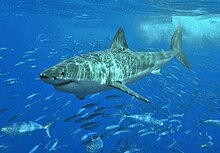
White shark at Isla Guadalupe, Mexico
It is an epipelagic fish, observed mostly in inland tributaries in the presence of rich game like fur seals, sea lions, cetaceans, other sharks, and large bony fish species. It is an open-ocean dweller and has been recorded at depths of around 1,220 m (4,000 ft).[10] These findings challenge the traditional notion about the great white as being a coastal species.[10]
According to a recent study, California great whites have migrated to an area between Baja California and Hawaii known as White Shark Café, to spend at least 100 days before migrating back to Baja. On the journey out, they swim slowly and dive down to around 900 m (3,000 ft). After they arrive, they change behavior and do short dives to about 300 m (1,000 ft) for up to 10 minutes. Another white shark tagged off the South African coast swam to the southern coast of Australia and back within the year. This refuted traditional theories that white sharks are coastal territorial predators and opens up the possibility of interaction between shark populations that were previously thought to be discrete. Why they migrate and what they do at their destination is still unknown. Possibilities include seasonal feeding or mating.[11]
A similar study tracked a great white shark from South Africa swimming to Australia's northwestern coast and back, a journey of 20,000 km (12,000 mi; 11,000 nmi) in under 9 months.[12]
Anatomy and appearance
The great white shark has a robust large conical snout. The upper and lower lobes on the tail fin are approximately the same size (like some mackerel sharks).Great whites display countershading, having a white underside and a grey dorsal area (sometimes in a brown or blue shade) that gives an overall "mottled" appearance. The coloration makes it difficult for prey to spot the shark because it breaks up the shark's outline when seen from the side. From above, the darker shade blends with the sea and from below it exposes a minimal silhouette against the sunlight.
Great white sharks, like many other sharks, have rows of serrated teeth behind the main ones, ready to replace any that break off. When the shark bites it shakes its head side to side, helping the teeth saw off large chunks of flesh.
Size
Males reach maturity at 3.5–4.0 metres (11–13 ft), and females at 4.5–5.0 metres (15–16 ft). Adults on average are 4–5.2 metres (13–17.1 ft) long and have a mass of 680–1,100 kilograms (1,500–2,400 lb). Females are generally larger than males. It is widely accepted that the great white shark can approach 6.1 m (20 ft) in length and 1,900 kg (4,200 lb) in weight.[3] However, the maximum size is still subject to hot debate because such reports are often rough estimations or speculations performed under questionable circumstances.[13]For several decades, many ichthyological works, as well as the Guinness Book of World Records, listed two great white sharks as the largest individuals: a 10.9 m (36 ft) great white captured in Southern Australian waters near Port Fairy in the 1870s, and a 11.3 m (37 ft) shark trapped in a herring weir in New Brunswick, Canada in the 1930s. Some researchers question these measurements' reliability, noting they were much larger than any other accurately reported sighting. The New Brunswick shark may have been a misidentified basking shark, as the two have similar body shapes. The question of the Port Fairy shark was settled in the 1970s, when J. E. Randall examined the shark's jaws and "found that the Port Fairy shark was of the order of 5 m (17 ft) in length and suggested that a mistake had been made in the original record, in 1870, of the shark's length".[14]
According to J. E. Randall, the largest white shark reliably measured was a 6 m (19.7 ft) individual reported from Ledge Point, Western Australia in 1987.[14] Another great white specimen of similar size has been verified by the Canadian Shark Research Center: a female caught by David McKendrick of Alberton, Prince Edward Island in August 1988 in the Gulf of St. Lawrence off PEI. This female great white was 6.1 m (20 ft) long.[3] However, a larger great white shark specimen was verified by T. C. Tricas and J. E. McCosker in 1984. This specimen was 6.4 m (21 ft) long and had a body mass of about 3,324 kg (7,330 lb).[15]

Great white shark caught off Hualien County, Taiwan on May 14, 1997. It was reportedly almost 7 m (23 ft) in length, with a mass of 2,500 kilograms (5,500 lb).[16]
A close contender in size is the Tiger shark, Galeocerdo cuvier, with largest specimen reported to have been 7.4 metres (24 ft) in length along with a mass of 3,110 kilograms (6,900 lb).[19] Some other macropredatory sharks such as Greenland Shark, Somniosus microcephalus, and Pacific sleeper shark, Somniosus pacificus, are also known to rival these sharks in length.[20][21] The question of maximum weight is complicated by the unresolved question of whether or not to include the shark's stomach contents when weighing the shark. With a single bite a great white can take in up to 14 kg (31 lb) of flesh, and can consume several hundred kilograms of food.
The largest great white recognized by the International Game Fish Association (IGFA) is one landed by Alf Dean in south Australian waters in 1959, weighing 1,208 kg (2,660 lb).[13] Several larger great whites caught by anglers have since been verified, but were later disallowed from formal recognition by IGFA monitors for rules violations.
Adaptations
Great white sharks, like all other sharks, have an extra sense given by the Ampullae of Lorenzini, which enables them to detect the electromagnetic field emitted by the movement of living animals. Every time a living creature moves it generates an electrical field and great whites are so sensitive they can detect half a billionth of a volt. Even heart beats emit a very faint electrical pulse. If close enough, the shark can detect even that faint electrical pulse. Most fish have a less-developed but similar sense using their body's lateral line.To more successfully hunt fast and agile prey such as sea lions, the great white has adapted to maintain a body temperature warmer than the surrounding water. One of these adaptations is a "rete mirabile" (Latin for "wonderful net"). This close web-like structure of veins and arteries, located along each lateral side of the shark, conserves heat by warming the cooler arterial blood with the venous blood that has been warmed by the working muscles. This keeps certain parts of the body (particularly the stomach) at temperatures up to 14 °C (25 °F)[22] above that of the surrounding water, while the heart and gills remain at sea-temperature. When conserving energy the core body temperature can drop to match the surroundings. A great white shark's success in raising its core temperature is an example of gigantothermy. Therefore, the great white shark can be considered an endothermic poikilotherm, because its body temperature is not constant but is internally regulated.
Bite force
A 2007 study from the University of New South Wales in Sydney, Australia, used CT scans of a shark's skull and computer models to measure maximum bite force. The study reveals the forces and behaviors its skull is adapted to handle and resolves competing theories about its feeding behaviour.[23] In 2008, a team of scientists led by Stephen Wroe conducted an experiment to determine great white shark's jaw power and findings indicated that a specimen more than 6.1 m (20 ft) long could exert a bite force of over 18,000 newtons (4,000 lbf).[15]Ecology and behavior

A great white shark turns onto its back while hunting tuna bait
The great white shark is one of only a few sharks known to regularly lift its head above the sea surface to gaze at other objects such as prey; this is known as "spy-hopping". This behaviour has also been seen in at least one group of blacktip reef sharks, but this might be learned from interaction with humans (it is theorized that the shark may also be able to smell better this way, because smell travels through air faster than through water). The white sharks are generally very curious animals, display intelligence and may also turn to socializing if situation demands such.[24] At Seal Island, white sharks have been observed arriving and departing in stable "clans" of two to six individuals on a yearly basis. Whether clan members are related is unknown, but they get along peacefully enough. In fact, the social structure of a clan is probably most aptly compared to that of a wolf pack: each member has a clearly established rank, and each clan has an alpha leader. When members of different clans meet, they establish social rank nonviolently through any of a fascinating variety of interactions.[24]
Diet
Great white sharks are carnivorous, and prey upon fish (e.g. tuna, rays,[24] other sharks[24]), cetaceans (i.e., dolphins, porpoises, whales), pinnipeds (e.g. seals, fur seals,[24] and sea lions), sea turtles,[24] sea otters, and seabirds.[25] Great whites have also been known to eat objects that they are unable to digest. Upon approaching a length of nearly 4 metres (13 ft), great white sharks begin to target predominately marine mammals for food.[26] These sharks prefer prey with a high content of energy-rich fat. Shark expert Peter Klimley used a rod-and-reel rig and trolled carcasses of a seal, a pig, and a sheep to his boat in the South Farallons. The sharks attacked all three baits but rejected the sheep carcass.[27]Great white sharks' reputation as ferocious predators is well-earned, yet they are not (as was once believed) indiscriminate "eating machines". They are ambush hunters, taking prey by surprise from below. Near the now famous Seal Island, in South Africa's False Bay, shark attacks most often occur in the morning, within 2 hours after sunrise, when visibility is poor. Their success rate is 55% in the first 2 hours, falling to 40% in late morning, after which hunting stops.[24]
Hunting techniques vary by prey species. Off Seal Island the shark ambush cape fur seals from below at high speeds, hitting the seal mid-body. They go so fast that they can completely leave the water. The peak burst speed of these sharks is largely accepted in the scientific community to be above 40 kilometres per hour (25 mph). However further precision is still speculative.[28] They have also been observed chasing prey after a missed attack. Prey is usually attacked at the surface.[29]
Off California, sharks immobilize northern elephant seals with a large bite to the hindquarters (which is the main source of the seal's mobility) and wait for the seal to bleed to death. This technique is especially used on adult male elephant seals which can be as large or larger than the hunter and are potentially dangerous adversaries. Prey is normally attacked sub-surface. Harbour seals are simply grabbed from the surface and pulled down until they stop struggling. They are then eaten near the bottom. California sea lions are ambushed from below and struck mid-body before being dragged and eaten.[30]
White sharks attack dolphins and porpoises from above, behind or below to avoid being detected by their echolocation. Targeted species include dusky dolphins,[17] Risso's dolphins,[17] bottlenose dolphins,[17][31] Humpback dolphins,[31] harbour porpoises,[17] and Dall's porpoises.[17] Close encounters between dolphins and predatory sharks often result in evasive responses by the dolphins.[31] However, in rare cases, a group of dolphins may chase a single predatory shark away in an act of defense.[31] White shark predation on some species of whales have also been observed — white sharks often attack and prey upon pygmy sperm whales, Kogia breviceps, in the Mediterranean Sea.[32] In addition, white sharks also attack and prey upon beaked whales.[17][31]
Even though the great whites are known to generally avoid conflicts with each other, the phenomenon of cannibalism is not alien to this species. Large individuals may aggressively interact intraspecifically with small individuals. A 3 m (9.8 ft) long great white shark was nearly bitten into two by a reportedly 6 m (20 ft) long great white shark in Stradbroke Island, near Brisbane in Australia.[33]
White sharks also scavenge on whale carcasses. In one such documented incident, white sharks were observed scavenging on a whale carcass alongside tiger sharks.[34]
Reproduction
Little is known about great white shark behaviour in the way of mating habits. Birth has never been observed, but pregnant females have been examined. Great white sharks are ovoviviparous (eggs develop and hatch in the uterus, and continue to develop until birth). The great white has an 11 month gestation period. The shark pup's powerful jaws begin to develop in the first month. The unborn sharks participate in intrauterine-cannibalism: stronger pups consume their weaker womb-mates. Delivery is in spring and summer.Almost nothing is known about mating behavior. Some evidence points to the near-soporific effect of a large feast (such as a whale carcass) possibly inducing mating.
Great white sharks reach sexual maturity at around 15 years of age.[35] Maximum life span is believed to be more than 30 years. (see "references" below)
Natural threats
Although the great white is typically regarded as an apex predator in the wild, it is in rare cases, preyed upon by the larger orca (also known as a killer whale). Interspecific competition between the great white shark and the orca is probable in regions where dietary preferences of both species may overlap.[31] An incident was documented on October 4, 1997 in the Farallon Islands off California.[36] An estimated 4.7–5.3-metre (15–17 ft) female orca was seen purposely inducing tonic immobility in a great white shark. The orca held the shark upside down to induce the tonic immobility, and kept the shark still for fifteen minutes, causing it to suffocate and then proceeded to eat the dead shark's liver.[31][36][37] Another similar attack apparently occurred there in 2000, but its outcome is not clear.[38] After both attacks, the local population of about 100 great whites vanished.[37][38] Following the 2000 incident, a great white with a satellite tag was found to have immediately submerged to depth of 500 m and swum to Hawaii.[38] Great whites may have similarly avoided the much larger shark, C. megalodon.[17][38]Relationship with humans
Shark attacks
Main article: Shark attack
More than any documented attack, Peter Benchley's best selling novel Jaws and the subsequent 1975 film adaptation directed by Steven Spielberg provided the great white shark with the image of a "man eater" in the public mind.[39] While great white sharks have killed humans, they typically do not target them: for example, in the Mediterranean Sea there have been 31 confirmed attacks against humans in the last two centuries, most non-fatal. Many incidents seem to be "test-bites". Great white sharks also test-bite buoys, flotsam, and other unfamiliar objects, and might grab a human or a surfboard to identify it.However, some researchers have hypothesized that the reason the proportion of fatalities is low is not because sharks do not like human flesh, but because humans are often able to escape after the first bite. In the 1980s John McCosker noted that divers who dove solo and were attacked by great whites were generally at least partially consumed, while divers who followed the buddy system were generally rescued by their buddy. Tricas and McCosker suggest that a standard pattern for great whites is to make an initial devastating attack, and then wait for the prey to weaken before consuming the wounded animal. Humans' ability to move out of reach with the help of others, thus foiling the attack, is unusual for a great white's prey.[41]
Humans, in any case, are not appropriate prey because shark's digestion is too slow to cope with the human's high ratio of bone to muscle and fat. Accordingly, in most recorded attacks, great whites broke off contact after the first bite. Fatalities are usually caused by blood loss from the initial limb injury rather than from critical organ loss or from whole consumption.
A shark conservationist, Jimmy Hall, reported and documented his personal encounter with a very large great white shark, nicknamed as Schatzi, in December, 2005, in waters off Hawaii. This encounter received worldwide attention as it remained entirely peaceful. J. Hall was first cautious but later on swam with this shark without cage protection and touched it repeatedly while filming it simultaneously.[42]
Attacks on boats
Great white sharks infrequently attack and sometimes even sink boats. Only 5 of the 108 authenticated unprovoked shark attacks reported from the Pacific Coast during the 20th century involved kayakers.[43] In a few cases they have attacked boats up to 10 metres (33 ft) in length. They have bumped or knocked people overboard, usually 'attacking' the boat from the stern. In one case in 1936, a large shark leapt completely into the South African fishing boat Lucky Jim, knocking a crewman into the sea. Tricas and McCosker's underwater observations suggest that sharks are attracted to boats due to the electrical fields they generate.[44]Great white sharks in captivity
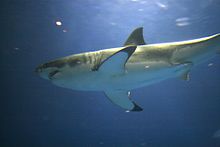
Great white shark in the Monterey Bay Aquarium in September, 2006
In 1984, shortly before its opening day, the Monterey Bay Aquarium in Monterey, California, housed its first great white shark, which died after 10 days. In July 2003, Monterey researchers captured a small female and kept it in a large netted pen near Malibu for five days. They had the rare success of getting the shark to feed in captivity before its release.[46] Not until September 2004 was the aquarium able to place a great white on long-term exhibit. A young female, who was caught off the coast of Ventura, was kept in the aquarium's massive 3.8E+6-litre (1,000,000 US gal) Outer Bay exhibit for 198 days before she was released in March 2005. She was tracked for 30 days after release.[47] On the evening of August 31, 2006 the aquarium introduced a juvenile male caught outside Santa Monica Bay[48] His first meal as a captive was a large salmon steak on September 8, 2006 and as of that date, he was estimated to be 1.72 metres (68 in) in length and to weigh approximately 47 kilograms (100 lb). He was released on January 16, 2007 after 137 days in captivity.
In addition, Monterey Bay Aquarium housed a third great white, a juvenile male, for 162 days between August 27, 2007 through February 5, 2008. On arrival, he was 1.4 metres (4 ft 7 in) long and weighed 30.6 kilograms (67 lb). He grew to 1.8 metres (5 ft 11 in) and 64 kilograms (140 lb) at release. A juvenile female came to the Outer Bay Exhibit on August 27, 2008. While she swam well, the shark fed only one time during her stay and was tagged and released on September 7. Another juvenile female was captured near Malibu on August 12, 2009, introduced to the Outer Bay exhibit on August 26, and successfully released to the wild on November 4, 2009.[49]
Probably the most famous captive was a 2.4 metres (7.9 ft) female named "Sandy", which in August 1980 became the only great white to be housed at the California Academy of Sciences' Steinhart Aquarium in San Francisco, California. She was released because she would not eat and constantly bumped against the walls.[50]
Shark tourism
Their infamous reputation gives sharks great appeal for tourists. While it is safe to dive near sharks of most species, diving with great whites requires great care. One common approach is for divers to stay within a steel cage.Cage diving is most common off the coasts of Australia, South Africa, and Guadalupe Island off the coast of Baja California, which great whites frequent. Cage diving & swimming with sharks is a focus for a booming tourist industry due to its popularity.[51][52] A common practice is to chum the water with pieces of fish to attract sharks. These practices may make sharks more accustomed to people in their environment and to associate human activity with food—a potentially dangerous situation. By drawing bait on a wire towards the cage, tour operators lure the shark to the cage, possibly striking it, exacerbating this problem. Other operators draw the bait away from the cage, causing the shark to swim past the divers.
At present, hang baits are illegal off Isla Guadalupe and reputable dive operators do not use them. Operators in South Africa and Australia continue to use hang baits and pinniped decoys.
Companies object to being blamed for shark attacks, pointing out that lightning tends to strike humans more often than sharks bite humans.[53] Their position is that further research needs to be done before banning practices such as chumming, which may alter natural behaviour.[54]
One compromise is to only use chum in areas in which whites actively patrol anyway, well away from human leisure areas. Also, responsible dive operators do not feed sharks; only sharks that are willing to scavenge follow the chum trail, and if they find no food at the end then the shark soon swims off and does not associate chum with a meal. It has been suggested that government licensing strategies may help enforce these suggested advisories.
The shark tourist industry has some financial leverage in conserving this animal. A single set of great white jaws can fetch a one-time price of up to £20,000. However, that is a fraction of the tourism value of a live shark, a more sustainable economic activity. For example, the dive industry in Gansbaai, South Africa, consists of six boat operators with each boat guiding 30 people each day. With fees between £50 to £150 per person, a single live shark that visits each boat can create anywhere between £9,000 and £27,000 of revenue daily.
Conservation status
It is unclear how much a concurrent increase in fishing for great white sharks has caused the decline of great white shark populations from the 1970s to the present. No accurate population numbers are available, but the great white shark is now considered endangered. Sharks taken during the long interval between birth and sexual maturity never reproduce, preventing population recovery.The IUCN notes that very little is known about the actual status of the great white shark, but as it appears uncommon compared to other widely distributed species, it is considered vulnerable.[2] It is included in Appendix II of CITES,[6] meaning that international trade in the species requires a permit.[55]
Fishermen target many sharks for their jaws, teeth, and fins, and as game fish in general. The great white shark, however, is rarely an object of commercial fishing, although its flesh is considered valuable. If casually captured (it happens for example in some tonnare in the Mediterranean), it is misleadingly sold as smooth-hound shark.
From April 2007 great white sharks were fully protected within 370 kilometres (200 nmi) of New Zealand and additionally from fishing by New Zealand-flagged boats outside this range. The maximum penalty is a $250,000 fine and up to six months in prison.[56]




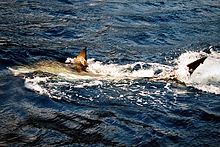

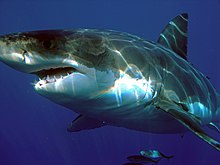


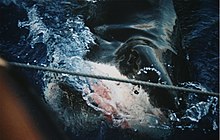

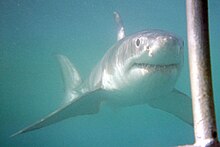

No comments:
Post a Comment